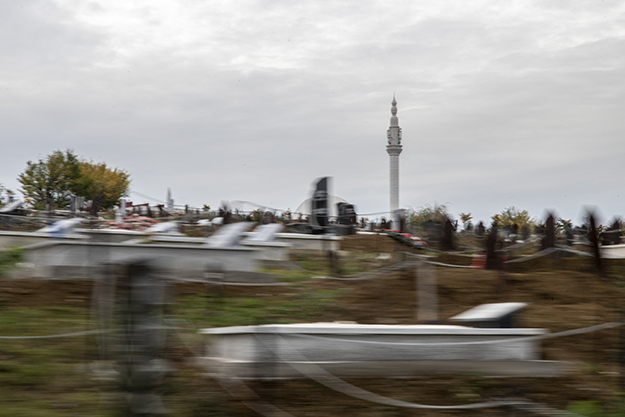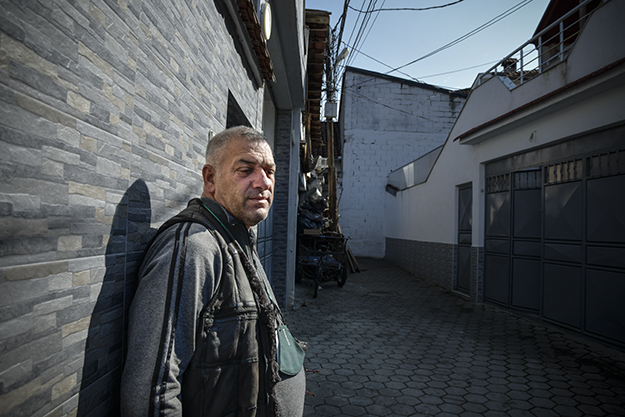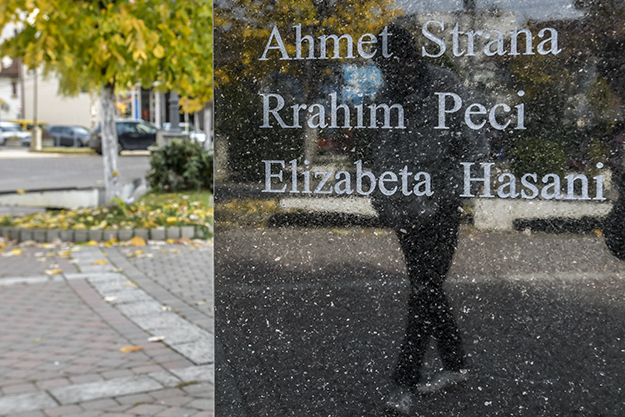“Imagine that…” says Senad*, looking directly at me, after reconstructing the pivotal summer day of 21 years ago. He pauses.
We had met an hour earlier in the yard of his cousin, a neighbor in a Roma neighborhood within a Serb majority village. Senad had immediately asked me to show my ID. Trust doesn’t come easily when discrimination, persecution and exploitation have become almost part of the ancestral DNA.
Episodes of intimidation and mistreatment by Serbian police until the end of the war in 1999 still haunt the family, as does the trauma of the immediate post-war period. The new reality of the two decades since have also been far from fair or pleasant.
The cousin, our common acquaintance, smoothes out the introduction and for an hour Senad narrates his story thoroughly. After he is done, he underscores the gravity of what he has just told me with an illustration.
“Imagine yourself leaving this house now, taking the street and then somebody abducts you,” he says. “You were at work, just doing your job and you are abducted. And then you are killed.”
– – –
On a July morning in 1999, four Roma men — Senad in his 20s, his younger brother and two cousins — left their village and headed to Prishtina for work. The dire living conditions — similar to today’s — necessitated their survival from short-term, ad hoc physical work. That day, a Kosovo Serb employed them to help him move out of his apartment in the center of Prishtina.
Senad recalls that as they were carrying the furniture down from the upper floor, a group of Albanian men gathered in front of the building and mocked them, pointing out that they were working for a Serb.
KFOR soldiers arrived on the scene. The Serb man had called NATO’s peacekeeping troops to ensure his safety on his journey out of Prishtina.
The war was officially over and almost 900,000 expelled Albanians continued to return to their liberated homes. But as they did so, a new kind of a complicated and gloomy reality was emerging.
The Albanian majority had endured long years of oppression and apertheid, in combination with a systematic campaign — orchestrated by the highest levels of the Serbian and Yugoslav governments in power at the time — to terrorize, kill and expel them.
They all left together toward a Serb-majority area — all except the four Roma men.
In the power vacuum created by the withdrawal of the Serbian war machinery, Serbs feared reprisal attacks, causing a large number to flee toward the north. The identification of many Serb civilians as participants in atrocities by paramilitary units only added to the tense atmosphere.
In the meantime, the prophecy of revenge attacks began to play out. Within weeks of Kosovo’s liberation, activists on the ground had documented violent attacks on minority communities — Serbs and Roma particularly — and political opponents by vengeful individuals and criminal gangs, but also individuals identified or linked with the Kosovo Liberation Army (KLA).
From their arrival in Kosovo in June 1999, NATO peacekeeping troops were charged with protecting the lives of those who were vulnerable in the aftermath of the war. With a duty to protect anyone exposed to threats of harassment, KFOR surrounded the lorry full of furniture belonging to the Serb home-owner who was leaving Prishtina for good. They all left together toward a Serb-majority area — all except the four Roma men.
“We were told that there wasn’t space for us in the lorry,” Senad says.
He recalls how they had started to walk through the city when suddenly two cars pulled up. Senad claims the men were Albanians, wearing civilian clothes and holding guns. He and one cousin managed to quickly escape and run to safety, but his brother and other cousin were dragged into the car.
Years later, officials would deliver the mortal remains of the two men to the family.
– – –
Senad’s father, who has so far sat in complete silence while his son has been speaking, inhales the last drag of his cigarette before he can no longer contain his outrage.
“He was only [a teenager]! And he just went to work because he had two small babies at home to feed,” he says in a loud voice. “He was not part of the JNA [Yugoslav National Army], or of any Serb military groups.”
The firm assertion that his son wasn’t a member of Serbian forces doesn’t come by coincidence. Kosovar Roma are still stigmatized today by much of the general public as willing collaborators in Serb abuses.
This narrative of Roma complicity in Serb atrocities against ethnic Albanians has been condemned as factually baseless by the European Roma Rights Centre (ERRC) since the immediate aftermath of the war.
Indeed, extensive evidence collected by ERRC suggests that while a few individuals might have served in the Yugoslav army and police, in the majority of cases, Roma were forced to work for the Serbian military and paramilitary. Furthermore Serbian paramilitaries regularly took advantage of the Roma’s vulnerable position, forcing them into acts such as collecting the bodies of Kosovar Albanians and burying them in mass graves.
ERRC researcher and activist Dimitrina Petrova stated back in 1999 that repeating statements that project Roma as collaborators added to the generalizing of all Roma in Kosovo as participants in the ethnic cleansing on the side of the Serbs. She called it a “racist slander” used as an attempt to legitimize the post-war violence toward the Roma, Ashkali and Egyptian communities.
“Indeed, if Roma had been perceived as loyal to the Serbs, why then thousands Roma joined the escaping ethnic Albanian refugees during the NATO bombing?” Petrova wrote. “There is abundant evidence collected by several organizations in many places that Roma were evicted from their houses at the same moments and during the same operations as ethnic Albanians.”

A common narrative has emerged in Kosovo that the Roma willingly collaborated with the Serbian side during the war, but the evidence shows this is factually baseless. Photo: Atdhe Mulla / K2.0.
Neighborhoods of Roma, Ashkali and Egyptian communities in different towns and villages visited by K2.0 carry vivid memories of persecutions by the Serbian forces. But caught between two sides where neutrality was not tolerated, freedom came later for them than for the majority population.
Perhaps the suppression of sharing stories of troubled experiences can be best described through the words of a Roma man in his 50s.
“I remember the Serb paramilitaries many times during the ’90s telling me: ‘We just have to finish first with the Albanians and then we will finish with you as well.’ Once they beat me very badly,” he says. “When Albanians came, they told us we were collaborators. Nobody cared about what Serbs did to us.”
Sian Jones is a former Amnesty International researcher who has long monitored human rights abuses in Kosovo, and she has been the author of the organization’s main reports on Kosovo for the past two decades. She highlights that Human Rights Watch and ERRC were on the ground immediately after the war and that both organizations found a clear pattern of intimidation toward minority communities.
“Some of the men they interviewed told them that KLA or ethnic Albanians told them directly to leave, others were abducted and sometimes tortured, and then returned to their families with the clear message that they should leave,” she says. “However, a substantial number of Roma — mainly men, often accused of collaboration with Serbs — were abducted and have not been seen since.”
Human Rights Watch observed that after the war there “were no more than a handful of U.N. police, leaving NATO’s peacekeeping troops to perform civilian policing functions for which they were ill-prepared,” and that together with the U.N. they “failed to take decisive action from the outset to curb the killings of Kosovo’s non-ethnic Albanian population, which set a precedent for the post-war period.”
Jones agrees with the statement of HRW and considers that the abduction and murder of minorities after the end of the Kosovo war in June 1999 was preventable.
“I think that one of the greatest ironies of the international communities’ intervention is that most of the killings and abductions of Roma — as well as Serbs — which took place in the immediate aftermath of the war took place under the eyes of KFOR, who had no real understanding of the situation on the ground, and failed to protect members of vulnerable minority groups from the wave of intimidation, threats and revenge killings that took place in the summer of 1999,” she says.
Missing recognition
The intimidating atmosphere of war was also inside the house of the Berisha family in the Janina neighborhood in the outskirts of Prizren, just a few kilometers away from a JNA barracks. In those amorphous days during the spring of 1999, young and old family members alike lost track of when to sleep and when to wake, just as they lost track of the number of displaced people entering and leaving their home en route to other safe shelters.
Kujtim and Nehat, two Berisha first cousins, recall how they feared their ethnicity might cause them an additional kind of danger. They identify as Ashkali, and the stories of Roma, Ashkali and Egyptian people being taken by Serbian forces at gunpoint had reached their household.
“There were many paramilitaries patrolling in the neighborhood,” Kujtim says. “We heard from our neighbors how they would take our men to do physical labor, such as digging trenches where Serbian forces would position themselves.”
On May 1, 1999, like on many days before that, they were hiding inside their house. Around lunchtime, they recall how something that felt like an explosion suddenly filled their ears, shaking the ground around them.
“We cannot go out and blame NATO. We also wanted the help from them to liberate us.”
Kujtim Berisha, family member of civilian war victims
Their first thought was, “NATO has probably bombed the military barracks,” and everybody ran in curiosity toward the window.
A few seconds later, an apocalyptic scene followed: darkness, physical pain and screams. Their house was in ruins, with bodies covered in concrete debris. NATO had mistakenly bombed the Berisha house and its surroundings, killing seven people, including Nehat’s 11-year-old son.
“Nobody ever visited us. Political parties never stopped here. But they mentioned the dead ones only before elections,” Kujtim says. “We cannot go out and blame NATO. We also wanted the help from them to liberate us, just as Albanians did.”
“We are like orphans,” Nehat adds. “Without parents, all forgotten, and left living in misery.”

Nehat Berisha’s 11-year-old son was killed in May 1999 during a NATO air strike that took the lives of seven civilians. Photo: Atdhe Mulla / K2.0.
According to the Humanitarian Law Centre in Kosovo 10,093 civilians died or went missing during the war, including 8,645 Albanians, 1,013 Serbs, 262 Roma, Ashkali and Egyptians and 84 Bosniaks.
But stories and experiences of non-Albanian victims, particularly Roma, Ashkali and Egyptians, are rarely found in the public discussion.
Human rights activist Agim* says that the inclusion of anybody other than Albanians and Serbs in the narrative of the war is practically nonexistent in Kosovo right now.
“For example, most of the things you will read and hear from the war are ‘this many Albanians,’ ‘this many Serbs’ and then ‘the others,’” he says. “And it will take a very long time for anybody to really start a real discussion about what Roma people went through, especially sharing their stories.”
Earlier this year, there was a public backlash surrounding a memorial in Mitrovica, after it was highlighted that Roma, Ashkali, and Egyptian victims of war are often missing from memorializations of people who lost their lives.

The name of 5-year-old Elizabeta Hasani was only added to a memorial dedicated to victims of the massacre she was killed in after a recent public backlash. Photo: Atdhe Mulla / K2.0.
Historian and publicist Shkëlzen Gashi was working on a project for his organization ADMOVERE, which seeks to objectively document the massacres that took place in Kosovo between 1998 and 2000, when he discovered the failure to include a young Roma girl’s name on a plaque commemorating war victims. While researching the Green Market Massacre in Mitrovica, he came across some data discrepancies, and found that the memorial plaque in the center of the city, erected by the Municipality of Mitrovica, contained only the names of the six Albanians killed, with no mention of 5-year-old Elizabeta Hasani.
When Gashi publicly condemned the Municipality of Mitrovica in August, there was an outpouring of support for his criticism from journalists, publicists, activists and many other citizens. A few days later the Municipality of Mitrovica added Elizabeta Hasani’s name to the memorial.
“So far, I know of three massacres committed by the Serbian and Yugoslav police and military forces in which there were members of ethnic minorities among the massacred, namely Roma, and none of them are mentioned in the memorials of these massacres,” Gashi says. “Of course, the exception is Elizabeta Hasani, whose name has now been included after 20 years.”
Missing a voice
Memorialization isn’t the only way in which Roma, Ashkali and Egyptians are missing from official processes relating to the war, despite on paper having the same rights as any other citizen.
In December 2011, the Kosovo Assembly adopted the Law on the Status and Rights of the Martyrs, Invalids, Veterans, Members of the Kosovo Liberation Army, Sexual Violence Victims of the War, Civilian Victims and their Families. Under this law, family members of the missing — defined as a person who was reported missing during the period between January 1, 1998 and December 31, 2000 — are entitled to certain rights and benefits, including social assistance and free healthcare. If families are suffering economic hardship, they are also entitled to further benefits under the law.
Jones explains that in cases where mortal remains are found and identified, families then become eligible to receive the social assistance for civilian victims of war. Such compensation would not only help to provide a little dignity and restore some rights as relatives of those who were killed and are missing, but it would also help family members forced to live in desperate living conditions.
“I’m teased by Serbs in the village who tell me, ‘How can you work for an Albanian as they abducted your son.’”
Father of civilian war victim
However, through speaking with numerous Roma families and rights organizations, K2.0 found that some Roma families have been unable to access any compensation that they are entitled to from the state as family members of missing people or civilian victims.
Senad and his father say that no members of their family receive any compensation for their abducted and killed relatives. They explain that they have tried to go to the relevant local Ministry of Labor offices on many occasions in order to apply, but that on each occasion they have been dismissed out of hand. One reason for this, according to Roma rights activists, is the systematic racism that Roma people face on a daily basis when dealing with institutions.
“I’m teased by Serbs in the village who tell me, ‘How can you work for an Albanian as they abducted your son,’” Senad’s father says. “But we don’t have any assistance and I, an old man, do physical work because I need to keep the children of my dead son who are grown up but cannot find work. I know that others are receiving the money for their killed relatives. All the Serbs that I know take the money.”
In Prizren, the Berisha family say that they only learnt about the social assistance scheme by accident a few years ago and until then had no information about the rights entitled to family members of civilian victims. Since finding out about the scheme and applying, Nehat, as the father of the victim, has been granted the monthly benefit of 170 euros.
Part of the issue is that while there are strong associations that represent Albanian civilians who went missing during the war, and other associations that represent Serbs, there is no such organization to represent the families of Roma, Ashkali and Egyptian communities. Much of the information that relatives of the missing receive is through these associations that have direct contacts with key actors working on the issue of missing people, such as the Government Commission on Missing Persons.
The Commision told K2.0 that they have never been approached by an association or individuals asking about the Roma, Ashkali and Egyptians that went missing during the war.
Jones says that in the two decades since the war there has also been a distinct lack of institutional effort to communicate with Roma people or to establish their needs.
“There is fear as such, that something is gonna happen to you, if you stand up and discuss these issues.”
Agim, human rights activist
She recalls interviewing displaced Roma people in the Konik camp in Montenegro in June 2002. “None had contacted the authorities, and at that time they did not want to go back to Kosovo to do so,” she says. “Around 1,000 of them remain in Konik.”
When it comes to the lack of efforts from relatives of missing Roma to raise their voice about their loved ones, both Jones and Agim come back to the same word: fear.
“Some of them still live in fear. When I say fear I am talking about psychological fear that OK, we have loved ones who went missing in Kosovo and coming back here gives them a threat to their life,” Agim says. “There is fear as such, that something is gonna happen to you, if you stand up and discuss these issues.”
He explains that even he, who considers himself a human rights activist, not just a Roma activist, was only prepared to talk anonymously to K2.0, because like others he is scared of being attacked and stigmatized by people around him for speaking up.
“These are facts of life,” he says. “Being a Roma is like that in Kosovo.”
He says that only with new generations will there be a chance to freely discuss what happened to the Roma during the war.
“Maybe in the future,” he says. “When I say in the future, I mean the far future.”K
Feature image: Atdhe Mulla / K2.0.
* Some names of individuals have been changed at their request to protect their identities.

Back to Monograph





